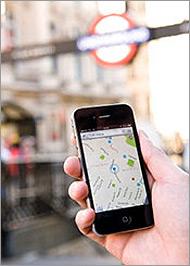Location-Tagging Up, Check-Ins Down
- by Mark Walsh @markfwal, September 12, 2013
 A new survey indicates that people are becoming more comfortable with sharing their location via social media. Almost a third (30%)
of adult social media users say at least one of their accounts is currently set up to include their location in posts -- up from 14% in 20ll, according to a the study by the Pew Research
Center’s Internet & American Life Project.
A new survey indicates that people are becoming more comfortable with sharing their location via social media. Almost a third (30%)
of adult social media users say at least one of their accounts is currently set up to include their location in posts -- up from 14% in 20ll, according to a the study by the Pew Research
Center’s Internet & American Life Project. People under 50 and those living in suburban areas are the most likely to tag their location on social networking sites. Otherwise, there was no significant difference by gender, education level or household income. That’s a change from two years ago, when men, lower-income African-Americans and Hispanics, and less educated people were most likely to use automatic location-tagging.
A separate Pew report released in May found that 16% of teens using location-tagging.
While people are more apt to tag their location in social media updates, fewer are using geosocial services like Foursquare to “check in” to locations or share where they are with friends. As of May 2013, 12% of smartphone owners were checking in compared to 18% in February 2012. For all adults, this represents a drop from 10% to 7%.
Facebook was the most popular platform for checking in with 39% of mobile users relying on that option, followed by Foursquare at 18%, and Google Plus at 14%. The decline in the share of people checking in doesn’t bode well for Foursquare, since the accuracy of its location information and recommendations still relies on its check-in data.
Even so, the Pew study found that nearly three-quarters (74%) of adult smartphone users say they get directions or other information based on their location. That’s the same level as in February 2012. But among all adults, the proportion has risen from 41% to 45%.
While the Pew studies have tracked location-based services that provide proximity-based information like directions separately from geosocial services for checking in to locations, the latest report noted that the line between the two is blurring.
“It is becoming increasingly difficult to delineate these two categories, as social media services incorporate location as an element of user activity and as location-centric services embrace varying degrees of social functionality," stated the report authored by Pew Research Associate Kathryn Zickuhr.
The findings were based on data from telephone interviews conducted by from April 17 to May 19 among a sample of 2,252 people 18 and older. Interviews were conducted in English and Spanish by landline and cell phone.


